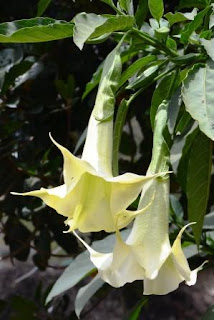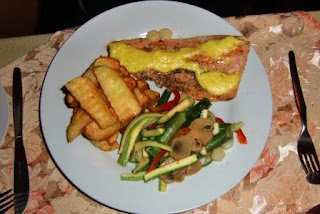We were woken up at 5.30 am every day when one of the porters came by the tent and gave us tea. A few minutes later he would come again, saying "agua caliente", which means hot water. After having some tea and a very quick morning shower, we packed all our belongings and got up for breakfast which the porters had already prepared for us. While we were enjoying our breakfast the porters took down and packed our tents.
Some people are more awake then others at 5.30 am. Guess which kind I am...
It always felt a bit bad to have the porters doing everything for us. We were told to not help them with for example taking down the tents, since they would do it faster on their own. This is probably true since they had done it quite a few times before. They were also responsible for the tents, so that if we would have damaged them, the porters would have to pay for it.
A small river crossing the trail.
Beautiful view early on the second day.
You can see the trail going up just above the trees.
Every now and then you hear someone shouting "porters", which means that there are porters wanting to pass you in the trail. Despite their heavier load they easily pass (most) tourists. When you see that some porters want to pass, you shout "porters" to let the people in front know that there are faster people coming. This also works if you want to pass a slower group yourself.
Some of the porters have serious trekking shoes, but many run around in sandals. Then they often also put grass in the sandals to improve the friction when they start getting wet from sweat. It looks a bit funny, but it seems to work well, at least for them and their feet that are used to it. I don't think it would have worked as well for me.
Most of the porters use really large backpacks, but some of them simply carry enormous bags that they tie together themselves, see the picture below. I even saw some of them carry fancy modern backpacks inside bags as the one below. First I thought this very strange, but then I noticed how they somehow wrap the bag around their shoulders, which should spread the weight better and might make it easier than a normal backpack. They are also used to using this kind of construction, so it seems to work well.
There are many different companies operating on the Inka Trail and organising these treks. There seem to be some that are very good, some that are less good where for example the porters are not treated so nicely, but most seem to be good. I think that as long as you choose a serious company, you can't really go wrong. Most of the companies are probably from Peru, but there are also some foreign companies. These can be very good, but I agree with our guide who said that he prefers if people choose the Peruvian companies (not necessarily his company) since the money then stays in Peru and doesn't go to the for example Canadian companies.

Some llamas enjoying the view.
The last place where you can buy water and snacks is another campsite called Llulluchampa. The prices constantly increases the further along the Inka Trail you are, so this is also the most expensive place. The price also seemed to depend on who you were and how much Spanish you spoke. We didn't camp here, but we did stop for some snacks and to watch the Llamas.
It is a bit cold in the morning when you start hiking, so you wear an extra shirt, but you quickly get warm when you start walking upwards, so you start stripping. However, it starts getting windy after a while, which makes it cold again, especially if you are a bit sweat. So you need to put on more clothes. We ended up taking a lot of breaks for all these changes of clothes. It didn't hurt that this allowed us to catch our breaths a bit as well.
It is especially cold up at the top of Dead Woman's pass, where we dressed in all our warmest clothes, including the typical Peruvian hats.
The weather changed very fast up at these altitudes. The pictures above and below are taken over the same valley and just a few minutes apart. The view is from Dead Woman's pass and shows the trail we walked down after having enjoyed the top for a while. This part of the trail is quite steep in some parts, but it's not very far to the next lunch and campsite.
At some point during the hike, we started discussing if there was anything that we missed from our "normal" life. Family and friends did not count, instead we discussed more material things. We mentioned computers, phones, internet, TV, a proper bed, shower etc. but we couldn't really think of anything. We enjoyed the trip so much that we didn't really miss anything. A little while later when having to go to the bathroom, however, we realised that we all missed a proper clean toilet. There are toilets in all campsites and in some stops along the way, but they are all of the "hole-in-the-floor" kind. Since 500 people pass through the park every day, these toilets are used by 500 people every day, so you can imagine how clean they are... Then there is also the possibility to use the Inka toilets, which you can find everywhere in nature.
View from the pass down towards where we started the day. The picture on the right is zoomed in at the bottom of the valley, where we camped the night before.
The porters always go/run fast on the trail in order to get to the lunch place or campsite before us tourists, so that they can set up the tents, prepare food and so on. In the beginning it really felt like we had our own servants or even slaves, because we never really had a chance to get to know them. We didn't have meals together, see each other very much on the trail or even talk very much in the campsites in the beginning. One issue is that some of them only speak Quechua, many also know some Spanish but since most of us didn't, this didn't help much. After a while we found out that one of our porters spoke English so we got to know him better, and S. really enjoyed practicing her Spanish with the other porters and the chef. We felt much better after making friends with them, than before when they were just these "magical creatures" who invisibly fixed everything for us. OK, they were still doing all the work, but now we felt like a big group together and not as a few tourists with a bunch of servants.

S. helping out in the campsite.
We reached the second campsite, Pacaymayu around lunch time and had both lunch and dinner there. It's incredible how tasty food the chef managed to cook on the little stove you see in the picture, and only using what they were carrying with them on the trail.
The second campsite, not too bad either...
View from the second campsite.
We recharged our batteries with an Inka happy hour, with popcorn, cookies and so on.

























































